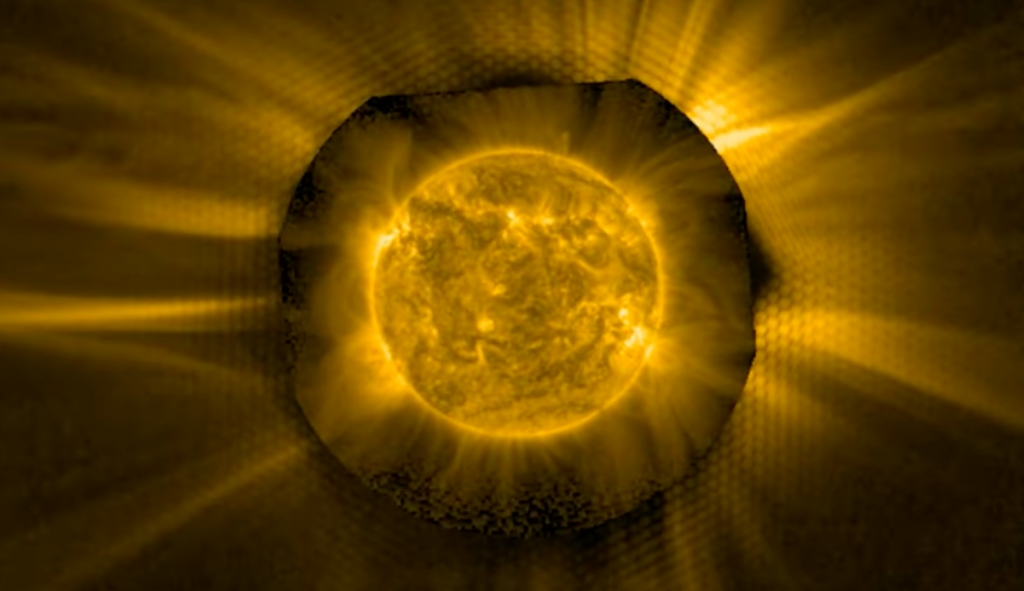Scientists have come up with a way to look directly into the corona of the cosmic luminary.
Scientists working on a solar-observing spacecraft project have applied a simple trick to one of its cameras, allowing them to study infrequently observed regions of the Sun's atmosphere.
Thanks to a small modification on Solar Orbiter's Extreme Ultraviolet Imager (EUI) camera, the team was able to record part of the Sun's atmosphere at extremely ultraviolet wavelengths. This modification consisted of adding a small projection that blocked out the bright light coming from the Sun, which would allow the fainter light of its atmosphere to be seen.

Frederic Osher, an astrophysicist at the Institute of Astrophysics at the University of Paris-Sud and a member of the EUI team, said: "It was a real hack. I got the idea to just make it and see if it works. This is actually a very simple modification of the instrument."
EUI creates high-resolution images of structures in the Sun's atmosphere. The result was an ultraviolet image of the Sun's corona. The ultraviolet image of the Sun's disk was superimposed in the center, in an area left empty by this "hack", as reported by the European Space Agency (ESA).
The corona is usually obscured by the bright light of the Sun's surface and is mostly visible during a total solar eclipse. The camera hack creates an effect similar to the eclipse effect, blocking out the sun's light. The corona's temperature reaches 1.8 million degrees Fahrenheit( 1 million degrees Celsius), which is one of our star's greatest mysteries.
Daniel Muller, ESA project scientist for Solar Orbiter, said:"We have shown that the method works so well that we can now consider a new type of instrument that can simultaneously produce images of the Sun and its corona."
ESA's Solar Orbiter was launched in 2020 with the goal of capturing images of the Sun at its closest distance, using six tools to solve the mysteries of this star.
Scientists working on a solar-observing spacecraft project have applied a simple trick to one of its cameras, allowing them to study infrequently observed regions of the Sun's atmosphere.
Thanks to a small modification on Solar Orbiter's Extreme Ultraviolet Imager (EUI) camera, the team was able to record part of the Sun's atmosphere at extremely ultraviolet wavelengths. This modification consisted of adding a small projection that blocked out the bright light coming from the Sun, which would allow the fainter light of its atmosphere to be seen.

Frederic Osher, an astrophysicist at the Institute of Astrophysics at the University of Paris-Sud and a member of the EUI team, said: "It was a real hack. I got the idea to just make it and see if it works. This is actually a very simple modification of the instrument."
EUI creates high-resolution images of structures in the Sun's atmosphere. The result was an ultraviolet image of the Sun's corona. The ultraviolet image of the Sun's disk was superimposed in the center, in an area left empty by this "hack", as reported by the European Space Agency (ESA).
The corona is usually obscured by the bright light of the Sun's surface and is mostly visible during a total solar eclipse. The camera hack creates an effect similar to the eclipse effect, blocking out the sun's light. The corona's temperature reaches 1.8 million degrees Fahrenheit( 1 million degrees Celsius), which is one of our star's greatest mysteries.
Daniel Muller, ESA project scientist for Solar Orbiter, said:"We have shown that the method works so well that we can now consider a new type of instrument that can simultaneously produce images of the Sun and its corona."
ESA's Solar Orbiter was launched in 2020 with the goal of capturing images of the Sun at its closest distance, using six tools to solve the mysteries of this star.
